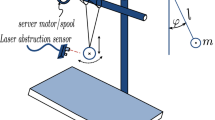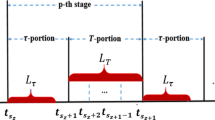Abstract
A simple proportional observer design method is presented for a class of linear port Hamiltonian systems. This observer design approach is based on the use of a powerful tool derived from continuum mechanics and differential geometry, known as contraction analysis. Under two verifiable assumptions, it is shown that error dynamics between the plant and the observer states converges exponentially to zero. Finally, our design method is applied to two physical systems arising from different domains: The DC motor and the RLC circuit.


Similar content being viewed by others
References
Duindam V, Macchelli A, Stramigioli S, Bruyninckx H (2009) Modeling and control of complex physical systems-the port-hamiltonian approach. Springer, Berlin
Maschke B, Van Der Schaft A, Breedveld PC (1992) An intrinsic Hamiltonian formulation of network dynamics: non-standard Poisson structures and gyrators. J Franklin Inst 329(5):923–966
Van Der Schaft A, Maschke B (1995) The Hamiltonian formulation of energy conserving physical systems with external ports. AEÜ Int J Electron Commun 49:362–371
Van Der Schaft A, Jeltsema D (2014) Port-Hamiltonian systems theory: an introductory overview. Found Trends Syst Control 1(2):173–378
Lohmiller W, Slotine JJE (1998) On contraction analysis for nonlinear-systems. Automatica 34(06):683–696
Shim H, Seo JH, Teel AR (2003) Nonlinear observer design via passivation of error dynamics. Automatica 39(5):885–892
Venkatraman A, Van Der Schaft A (2010) Full order observer design for a class of port hamiltonian systems. Automatica 46:555–561
Vincent B, Hudon N, Lefevre L, Dochain D (2016) Port-Hamiltonian observer design for plasma profile estimation in tokamaks. Ifac-PapersOnline 49(24):093–098
Wang Y, Ge SS, Cheng D (2005) Observer and observer-based H\(\infty \) control of generalized Hamiltonian systems. Sci China Ser F 48(2):211–224
Bakhshande F, Söffker D (2015) Proportional-integral-observer: a brief survey with special attention to the actual methods using ACC Benchmark. Ifac-PapersOnLine 48(1):532–537. https://doi.org/10.1016/j.ifacol.2015.05.049
Rakesh PB, Maghade DK, Sondkar SY, Pawar SN (2021) A review of PID control, tuning methods and applications. Int J Dynam Control 9:818–827. https://doi.org/10.1007/s40435-020-00665-4
Lohmiller W, Slotine JJE (1998) On contraction analysis for nonlinear-systems. Automatica 34(06):683–696
Lohmiller W, Slotine JJE (2000) Control system design for mechanical systems using contraction theory. IEEE Trans Automat Control 45(05):984–989
Van Der Schaft A (2000) L2- gain and passivity techniques in nonlinear control. Springer, Berlin
Ortega R, Garçia-Canseco E (2004) Interconnection and damping assignment passivity-based control: a survey. Eur J Control 10(5):432–450
Khalil HK (2002) Nonlinear systems, 3rd edn. Prentice Hall, New York
Van Der Schaft A, Maschke B (1995) The Hamiltonian formulation of energy conserving physical systems with external ports. AEÜ Int J Electron Commun 49:362–371
Van Der Schaft A, Jeltsema D (2014) Port-Hamiltonian systems theory: an introductory overview. Found Trends Syst Control 1(2):173–378
Venkatraman A, Van Der Schaft A (2010) Full order observer design for a class of port hamiltonian systems. Automatica 46:555–561
Medianu S, Lefèvre L (2021) Structural identifiability of linear Port Hamiltonian systems. Syst Control Lett. https://doi.org/10.1016/j.sysconle.2021.104915
Navarro D, Cortes D, Galaz-Larios M (2017) A port-Hamiltonian approach to control DC-DC power Ccnverters. Stud Inf Control 26(3):269–276. https://doi.org/10.24846/v26i3y201702
Zhang M, Ortega R, Jeltsema D, Su H (2015) Further deleterious effects of the dissipation obstacle in control-by-interconnection of port Hamiltonian systems. Automatica 61:227–231
Author information
Authors and Affiliations
Corresponding author
Rights and permissions
About this article
Cite this article
Zenfari, S., Laabissi, M. & Achhab, M.E. Proportional observer design for port Hamiltonian systems using the contraction analysis approach. Int. J. Dynam. Control 10, 403–408 (2022). https://doi.org/10.1007/s40435-021-00830-3
Received:
Revised:
Accepted:
Published:
Issue Date:
DOI: https://doi.org/10.1007/s40435-021-00830-3




